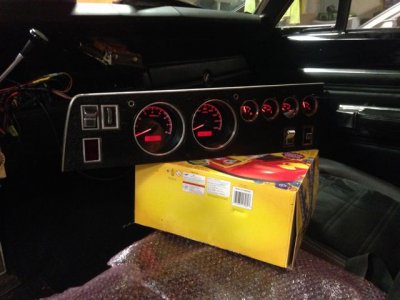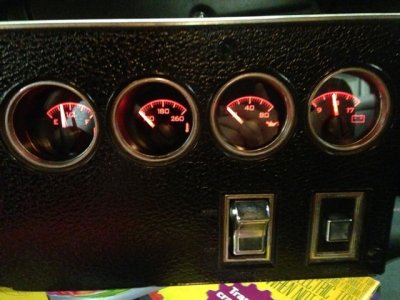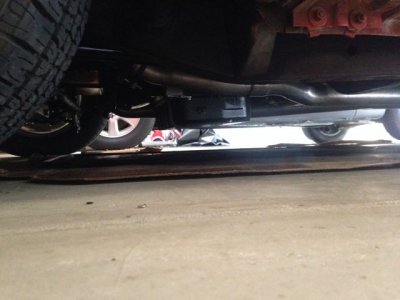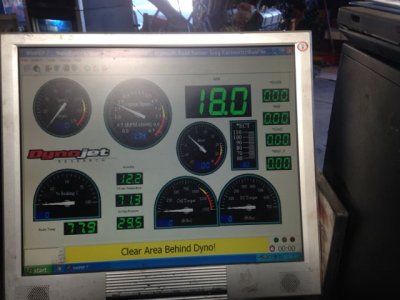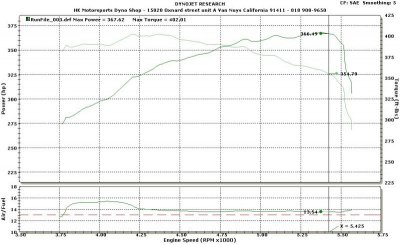Well I am off on my latest project - to replace the stock fuel tank with an aftermarket aluminum tank with a tank-mounted fuel pump capable of supporting my current carburetor and maybe eventually a fuel injection system. I found a tank from a place which is local to me called Hot Rod City Garage. They are a Vet-owned business and do very pretty aluminum work. The tank has not only an internal pump, but a linear, vertical fuel gauge sender, a sump near the pickup and internal baffles to keep the fuel from sloshing around. And a drain. As far as I'm concerned, ANYTHING that hold liquid should have a drain. Damn transmission pans! I HATE transmission pans...
Sorry - Not the greatest picture.
View attachment 298862
I also bought an Aeromotive Fuel Pressure Regulator which has the capability (through changing the internal spring) to support 3 to 10 psi fuel pressure for carburetors and up to 60 psi for fuel injection. That way if I go to fuel injection I don't have to buy a new regulator.
View attachment 298861
I'll admit that what looks like an easy project - bolt the new tank into the stock location - quickly becomes a serious one when you start having to run high pressure fuel delivery and return lines from the tank to the engine bay, and then to mount the regulator neatly. Wiring the power for the fuel pump was the easiest part of the project, that's for sure.
I had originally intended to run flexible braided lines (the black nylon braided type) from the tank to the engine bay, but have had numerous people tell me of the great danger of doing so (some sarcasm here) - What if you have an accident. That line can be easily cut... the options are essentially to run aluminum or steel line from a short "whip" at the tank to another short flexible whip at the regulator. I need to take pictures to do that job justice and share it with you, but boy is that a chore. For now, I'll show you what i ended up with at the carburetor end, because that is what I have pictures of.
Let me start by saying that what appears in the photos to be hundreds of dollars of aluminum AN fittings is, in fact, hundreds of dollars of aluminum AN fittings! To be fair, it's HALF of the total number I bought, tried, and then set aside! Well maybe not that bad, but I have plenty of "spare parts" left...
Here is where I started. Note that the coil is side-mounted using a hemi-type coil bracket and I have a flex-line running between the two carb bowls.
View attachment 298876
View attachment 298873
And here's where I ended up. Fuel comes in from a line which runs up the firewall inside a silver flexible cloth heat shield to protect it from areas where it is nearest the last header tube on the passenger side. It's no closer than about 6 inches, but hey, it's FUEL hose. Can't be too careful. The fuel supply line is in the foreground with the inline filter visible and the ONE BLUE FITTING (I'll get rid of that).
The regulator is mounted to the "fuel rail" in between the carb bowls using both hard fittings and a short section of hose to allow the parts to have some flexibility and to be assembled. The tolerances are VERY tight. The fuel return line is just barely visible in the picture. It runs from the bottom of the regulator into the heat shield sleeve with the fuel supply hose.
I mounted a gauge on the end of the fuel rail but I may use that just for adjustment and then simply cap the end of the rail. Not sure it is really necessary to leave it on there permanently. I know in the end the layout looks simple, and I wrote it up for in 15 minutes, but MY GOD did it take a lot of fiddle-f!@#ing and figuring. This may be my most complicated project yet...
View attachment 298872
View attachment 298874
View attachment 298875
My understanding is that the in-tank pumps run relatively high pressures - up to 130psi - to support all kinds of modern injection systems. This means that I'll have lots of fuel bypassing the rail and running back to the tank, and SPRAYING back into the tank. The guys at Hot Rod City actually said they align the fittings at the pump such that the returning fuel runs over the pump to keep it cool when the tank is low. Even though a fuel injected engine runs higher rail pressures, the actual amount of fuel consumed is no higher than in the same carbureted engine, so my system should not be "circulating" any more fuel that and stock modern high pressure system. Seems odd though. Is that how modern systems work? Or do they simply deadhead at the rail, holding a constant pressure?
I haven't tested it yet as I'm not quite ready with all the lines to fill the tank. I wish I could test it with something other than gasoline just to check for leaks, but I guess there's no real danger in the gas as long as the engine is cold and not running. One advantage of the bypass is that I can test the whole system with the pump on and the engine not even running. The Fuel system shouldn't know whether the carb is drawing fuel or not...
Does this all sound safe and effective so far?
